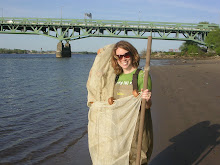 Sandy Hook is home to many beach nesting shore birds. Several sections of Sandy Hook's beaches are closed off from April-August to provide habitat for these migratory birds. Beach nesting birds (as their name implies) lay their eggs directly on the sand and are particularly vulnerable to human traffic on beaches. Closing off sections of the beach provides a safe haven for these birds to nest.
Sandy Hook is home to many beach nesting shore birds. Several sections of Sandy Hook's beaches are closed off from April-August to provide habitat for these migratory birds. Beach nesting birds (as their name implies) lay their eggs directly on the sand and are particularly vulnerable to human traffic on beaches. Closing off sections of the beach provides a safe haven for these birds to nest.Oystercatchers are a species of special concern in NJ because their populations appear to be declining. They nest both on the bay side and on beaches. While participating in an event last week, I noticed one pair of oystercatchers that chose not to nest in the protected area. Rather, they decided to nest at one of Sandy Hook's busiest beaches. In the middle of all the beach traffic sat one tiny egg and two frantic parents. I'm not sure what made this pair decide to nest here, I guess that they chose the spot before the nice weather and the beaches got busy.
 One woman at the event placed some sticks around the egg so that it wouldn't get stepped on. Unless you're looking for the egg, you would never notice it intermingled with all of the rocks and shells in the sand. Before human traffic on beaches was an issue, the eggs of beach nesting birds were beneficially camouflaged from predators. Unfortunately, this adaptation does not protect the oystercatchers from their biggest threat, people.
One woman at the event placed some sticks around the egg so that it wouldn't get stepped on. Unless you're looking for the egg, you would never notice it intermingled with all of the rocks and shells in the sand. Before human traffic on beaches was an issue, the eggs of beach nesting birds were beneficially camouflaged from predators. Unfortunately, this adaptation does not protect the oystercatchers from their biggest threat, people.New Jersey Fish and Wildlife has since put up string and flags around the area to keep people away from the egg. This pair of oystercatchers appears to be pretty skittish. Even though the egg is protected, the parents are still weary of the people on the beach and often fly away from the nest sight. Hopefully the mother is spending enough time on the nest for the egg to incubate. If the egg does hatch, there will certainly be problems if the parents continue to leave the chick alone at the nest site. Young chicks are often predated upon by gulls, fox, raccoons, and feral cats.
The odds are certainly against this oystercatcher family. However, if they are successful, it will be a wonderful opportunity for Sandy Hook's beach-goers to get an up close look at life on the hook.



Stevie ... great work ! We had good numbers of people and crabs at our walk last week. As for oystercatchers, they are increasing in NY State as a beach nester and have been implicated in destruction of piping plover nests & eggs. In 1975 theyw ere a rare species in NY; now they are nesting everywhere in Jamaica Bay. Don Riepe, Jamaica Bay Guardian
ReplyDelete